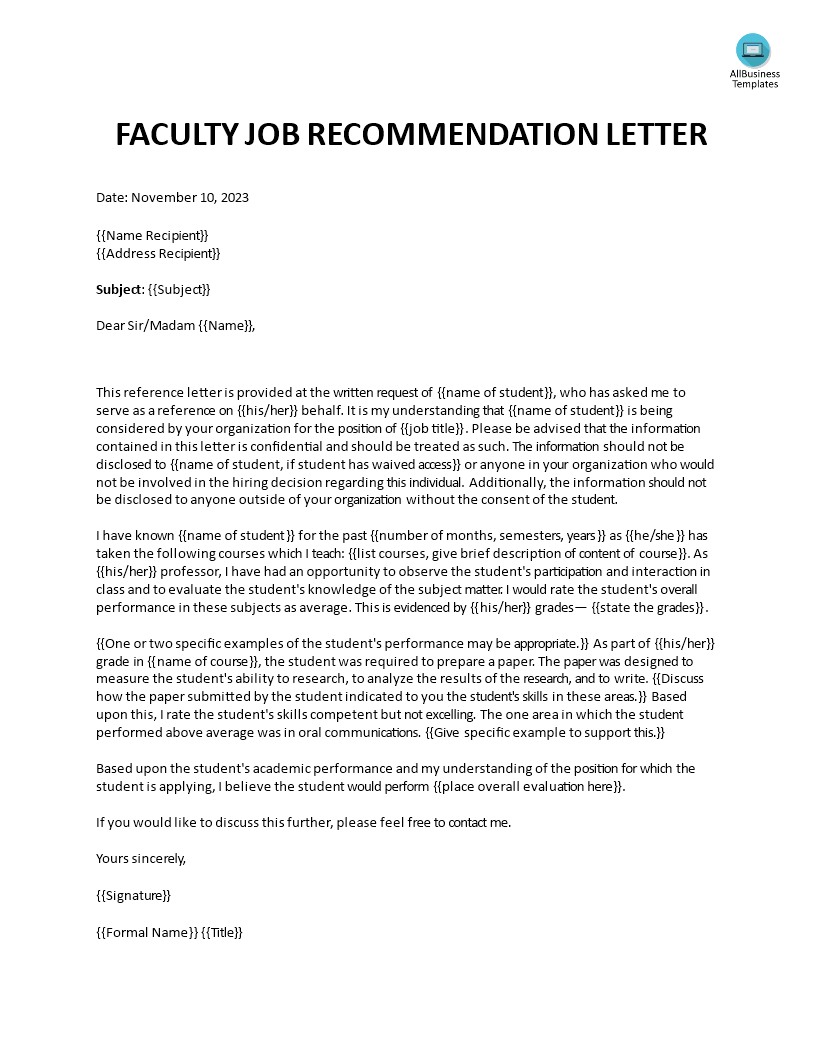Faculty Job Recommendation Letter

I-Save, punan ang mga blanko, i-printa, Tapos na!
How to draft a Faculty Job Recommendation Letter? What is the purpose of a faculty letter of recommendation? Download our faculty letter template now which will help you write a clear and concise recommendation letter.
Mga magagamit na premium na format ng file:
.docx- Itong dokumento ay sertipikado ng isang Propesyonal
- 100% pwedeng i-customize
Business Negosyo HR student Letter sulat letters Reference Sanggunian Recommendation rekomendasyon References Recommendation Letter Template In PDF Template ng Liham ng Rekomendasyon Sa PDF Recommendation Letter Templates In
How to draft a Faculty Job Recommendation Letter? What is the purpose of a faculty letter of recommendation? Our faculty letter template will help you write a clear and concise recommendation letter. It includes a sample letter as well as detailed instructions for customizing the letter to fit your situation. Our template is easy to use and download.
A faculty job recommendation letter, also known as an academic recommendation letter, is a document written by a professor, academic advisor, or other faculty member on behalf of a student, colleague, or former employee. This letter is typically used in the context of academia and is meant to support an individual's application for a faculty position, academic scholarship, research grant, or any other academic opportunity. The purpose of this letter is to provide a professional and informed assessment of the candidate's qualifications, skills, and potential as a scholar, teacher, or researcher.
Here are the key components of a faculty job recommendation letter:
- Letterhead: The letter should typically be written on the institution's letterhead, which includes the name and logo of the university or academic institution.
- Introduction: Begin by introducing yourself as the recommender and providing your own academic credentials and position. Mention how long you have known the candidate and in what capacity.
- Description of the Candidate: Provide a comprehensive assessment of the candidate's qualifications, academic achievements, and relevant skills. Discuss their academic strengths, research experience, teaching abilities, and any other relevant attributes.
- Specific Examples: Use specific examples or anecdotes to illustrate the candidate's qualities and achievements. Highlight any noteworthy research projects, publications, teaching experiences, or leadership roles they have taken on.
- Comparative Evaluation: If possible, compare the candidate to other students or scholars you have worked with to give context to your assessment.
- Suitability for the Position: Address the candidate's suitability for the specific faculty position or academic opportunity they are applying for. Discuss how their background and skills align with the requirements of the role.
- Teaching Abilities: If relevant, evaluate the candidate's teaching abilities, such as their classroom performance, teaching style, and interactions with students.
- Research Potential: Assess the candidate's potential for future research and contributions to their field. Discuss the significance of their research work and its impact.
- Character and Work Ethic: Comment on the candidate's character, work ethic, and professional conduct. Mention any qualities that make them a valuable addition to the academic community.
- Closing Statement: Summarize your recommendation and express your strong support for the candidate's application.
- Contact Information: Provide your contact information in case the recipient of the letter has further questions or needs additional information.
- Signature: Sign the letter by hand, as this adds a personal touch and authenticity to the recommendation.
Faculty job recommendation letters carry significant weight in academic circles, as they reflect the opinions of respected individuals in the field. When requesting such a letter, it's important to approach faculty members who know you well and can write a strong and positive recommendation based on their first-hand experience with your academic and professional abilities.
Download this Human Resources Faculty Job Recommendation Letter template now!
Reference and Recommendation Letters What is the difference Who writes reference or recommendation letters The term “References” usually applies to a job search while “Recommendations” refers to formal letters written to support an application for graduate school or a research position.. Useful Online Resources for Additional information: Guides to Writing Letters of Recommendation http://isites.harvard.edu/fs/html/icb.topic58474/Verba-recs.html http://www.writeexpress.com/reference-letter.html http://jobsearch.about.com/od/referencesrecommendations/ NACE Sample Faculty Reference Letter http://www.naceweb.org/about/public/formfacref.htm Information provided by GMU University Career Services NACE Sample Faculty Reference Letter Dear Name of Employer : This reference letter is provided at the written request of name of student , who has asked me to serve as a reference on his/her behalf..
Also interested in other HR templates? Browse through our database and have instant access to hundreds of free and premium HR documents, HR forms, HR agreements, etc
DISCLAIMER
Wala sa 'site' na ito ang dapat ituring na legal na payo at walang abogado-kliyenteng relasyon na itinatag.
Mag-iwan ng tugon. Kung mayroon kang anumang mga katanungan o mga komento, maaari mong ilagay ang mga ito sa ibaba.
